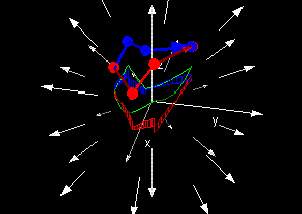|
Conservative Vector Fields
Text A vector field F(p,q,r) = (p(x,y,z),q(x,y,z),r(x,y,z)) is called conservative if there exists a function f(x,y,z) such that F = ∇f.
 If f exists, then it is called the potential function of F.
If f exists, then it is called the potential function of F.

If a three-dimensional vector field F(p,q,r) is conservative, then py = qx, pz = rx, and qz = ry.

Since F is conservative, F = ∇f for some function f and p = fx, q = fy, and r = fz. By the equality of mixed partials,
py = fxy = fyx = qx,
pz = fxz = fzx = rx,
qz = fyz = fzy = ry.

If a three-dimensional vector field F(p,q,r) is conservative, then its curl is identically zero.

Using the previous part,
\nabla \times F =
\left| \begin{array}
\vec{i} & \vec{j} & \vec{k} \\
\frac{d}{dx} & \frac{d}{dy} & \frac{d}{dz} \\
p & q & r
\end{array} \right| =
(r_y - q_z, p_z - r_x, q_x - p_y) = (0,0,0).

Demos
Conservative Fields

| 
|
For the most part, this demo works the same way as the demo in 2.5.4. The difference is that in determining a path, you must first choose the "shadow" of the path in the x-y plane and then choose the z coordinate of each point. 
|
Exercises 1. For each of the following, use the demo to determine whether or not the vector field F is conservative. If it is conservative, find the potential function of F.
- F = (x, y, z)
- F = (y - z, x + z, x + 2*y)
- F = ( 1, 1, z)
- F = (cos(x), sin(y), arctan(z))
- F = (x/(x2+y2+z2), y/(x2+y2+z2), z/(x2+y2+z2))
- F = ( 0, 0, -9.8)
2. In the 2-Variable lab on conservative fields, you have the option of plotting a surface that represents a function whose gradient is the vector field. Why will that not work for 3 variables? What could be used instead?
|